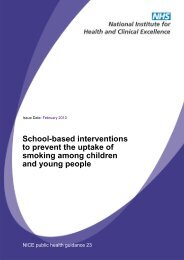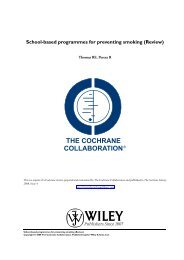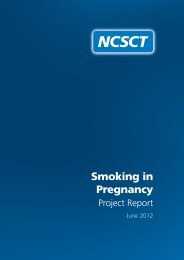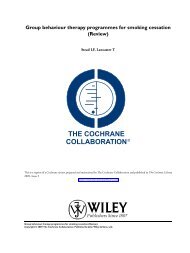Smoking and mental health - NCSCT
Smoking and mental health - NCSCT
Smoking and mental health - NCSCT
Create successful ePaper yourself
Turn your PDF publications into a flip-book with our unique Google optimized e-Paper software.
<strong>Smoking</strong> <strong>and</strong> <strong>mental</strong> disorders: special circumstances 7<br />
Glasgow, a specific looked-after children’s smoking cessation project was set up,<br />
involving <strong>health</strong> promotion advice, one-to-one support, <strong>and</strong> training of care staff<br />
around raising awareness <strong>and</strong> the importance of positive role models. 179 Given<br />
the association between smoking <strong>and</strong> <strong>mental</strong> illness, there is also a case for<br />
further integration <strong>and</strong> coordination of services, eg offering training on smoking<br />
cessation interventions to staff working in looked-after children CAMHS teams.<br />
Further work in these areas is clearly necessary.<br />
7.6.6 Summary points<br />
> <strong>Smoking</strong> prevalence is high among children with <strong>mental</strong> disorders, <strong>and</strong> both<br />
smoking <strong>and</strong> <strong>mental</strong> disorders are common in looked-after children.<br />
> Professionals working with or caring for young people should provide<br />
positive (ie non-smoking) role models <strong>and</strong> be trained to deliver cessation<br />
advice <strong>and</strong> provide or arrange further support for those who want help to<br />
quit.<br />
> CAMHS should ascertain smoking status <strong>and</strong> provide cessation support as a<br />
routine component of their service.<br />
> In settings where young people are most vulnerable, such as adolescent<br />
inpatient units, there should be a broad programme of <strong>health</strong> promotion<br />
aimed at preventing initiation of smoking as well as smoking cessation.<br />
> Local authority foster care <strong>and</strong> smoking policies should explicitly protect<br />
children from passive smoke, <strong>and</strong> promote smoke-free foster homes.<br />
7.7 Special circumstances summary<br />
> <strong>Smoking</strong>, <strong>and</strong> particularly high levels of nicotine dependence, are especially<br />
common among people in forensic psychiatric settings, prisons, homeless<br />
people, <strong>and</strong> those with alcohol or other drug misuse.<br />
> <strong>Smoking</strong> is also engrained in the culture of many of the institutions that<br />
care or provide for these groups.<br />
> People in these populations are no less likely to want to quit smoking,<br />
although the likelihood of success in any quit attempt may be lower than for<br />
the general population of smokers, <strong>and</strong> smokers may also encounter<br />
obstacles to engagement with existing cessation services.<br />
> It is therefore a priority to establish smoke-free cultures <strong>and</strong> to provide<br />
suitable smoking cessation support for all smokers, particularly those with<br />
high levels of dependence, in these settings.<br />
> Interventions to address smoking concurrently with alcohol <strong>and</strong>/or drug<br />
misuse are effective <strong>and</strong> can also support alcohol <strong>and</strong> drug abstinence.<br />
> Women with <strong>mental</strong> disorders are more likely to smoke throughout<br />
pregnancy, but are also more likely to accept cessation support.<br />
© Royal College of Physicians 2013 153














